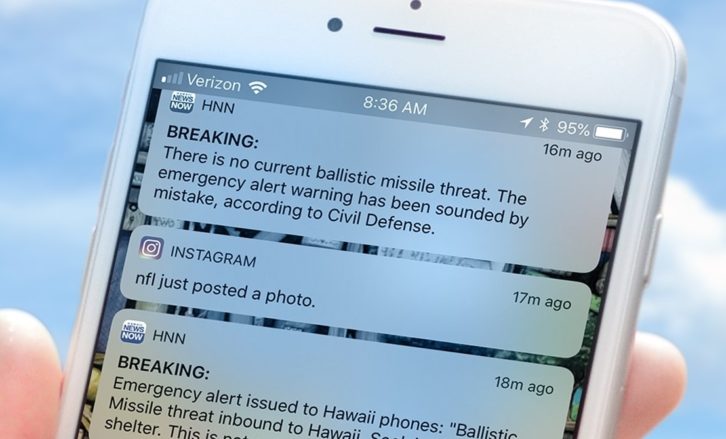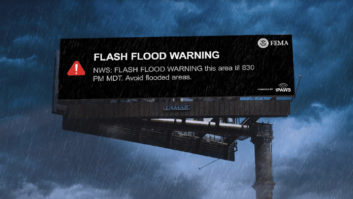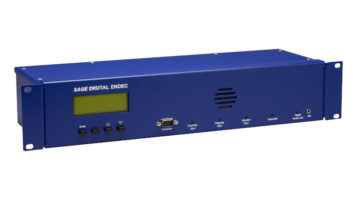
Congress wants better emergency alerting for the United States. So the Federal Communications Commission is working on several ways to accomplish that.
Among other things, the FCC wants to get state governments to improve their own alert coordination efforts. It wants to replace the WEA “Presidential Alert” with a “National Alert” that can be issued by the president or the Federal Emergency Management Agency, an alert that mobile users cannot turn off. And it wants to explore the possibility of alert dissemination via the internet.
The FCC, now under the leadership of Acting Chairwoman Jessica Rosenworcel, is taking public comments on proposed changes to the Emergency Alert System and Wireless Emergency Alert system.
Many of the steps are mandated by Congress, so the question for the commission is not whether to take them but how. The FCC said it’s crucial that emergency alerts include accurate information and that any new procedures be trustworthy.
The EAS, as most Radio World readers know, is the national public warning system through which broadcasters, cable systems and other EAS participants deliver alerts to warn the public of impending emergencies and dangers to life and property.
While best known for local weather and other warnings and tests, the system’s primary purpose is actually one for which it has never been used: to allow the president of the United States to provide immediate communications to the public in a national emergency.
Broadcasters are required to carry presidential alerts; they participate in state and local alerts voluntarily. The FCC, FEMA and the National Weather Service implement EAS at the national level.
The reform push comes at the direction of Congress as part of the National Defense Authorization Act for fiscal 2021. The spending bill included the Reliable Emergency Alert Distribution Improvement (READI) Act, which gave the FCC its charge.
One industry observer said they were “pleased with the elegant solutions the FCC crafted to meet the congressional mandates.”
Focus on the states
For one thing, the commission wants the 50 states and the U.S. territories to do a better job at managing their part of the alerting infrastructure.
The states and territories would be asked to review the composition and governance of their State Emergency Communication Committees. Those SECCs would be required to meet at least once a year and to submit an updated EAS plan annually; the FCC would have to accept or reject each plan within 60 days. The commission also would provide a checklist of information to be included in state plans.
One longtime EAS observer told Radio World they are pleased to see the FCC finally include rules that say state EAS plans are to be administered by the SECCs, something that has been missing from the rules.
The FCC also proposes that state plans, currently posted on its website, would not be publicly available except for names and contact information of SECC chairs.
[“FCC Issues an EAS Enforcement Advisory”]
“Disclosure of the plans, at least in form where each plan is one place and in a uniform and easily searchable format, could highlight potential vulnerabilities that malefactors could exploit, thereby potentially hindering emergency planning efforts,” it wrote.
Another change would enable jurisdictions to report false EAS or WEA alerts to the FCC Operations Center when they occur. The commission said such a system would allow planners to learn from incidents like the false missile alert in Hawaii that was distributed in 2018.
EAS participants are already required to report false alerts, but there’s no system for other stakeholders to report them voluntarily.
Repetition discussion
Congress also told the FCC to modify EAS to provide for the repetition of national security alerts issued by the president or FEMA. The commission devotes several lengthy paragraphs of its NPRM to the repetition issue and its associated mechanics.
The commission said the EAS system is already designed to allow repeated alerts from any originator as long as at least one minute has passed, but it said this capability may not be fully understood in the alerting community. It proposes to keep its rules regarding transmission and retransmission but add language specifying how an originator can repeat a message.
It thinks that automating the repetition of alerts, including setting the repetition intervals, should be achievable with “minimal changes” to alert software programs on the market, though it suspects that many encoder/decoder models would require modifications.
But it proposed that only the president or his or her designee be allowed to repeat the president’s Emergency Action Notification alert. It thinks that requiring EAS participants’ equipment to automatically repeat the alert would present technical impediments that may impair the president’s ability to issue EANs. For instance, requiring a predetermined interval of automatic repetition could cause problems in fast-evolving emergency situations.
It invited comments on a long list of questions including whether automatic (or manual) repetition of national security alerts by participants’ EAS devices is technically feasible. It also asked whether widespread repetition of state and local alerts might cause alert fatigue.
The NPRM also asks whether the FCC should adopt a National Command Authority (NCA) alert originator code for FEMA and whether it should create a National Security Event (NSE) event code for FEMA that would encompass “warnings of national security events, meaning emergencies of national significance, such as a missile threat, terror attack, or other act of war or threat to public safety.”
Veteran EAS observer Gary Timm said broadcasters should watch these developments closely, including the discussion about a methodology for repeating national-level alerts.
“The FCC proposed that the most obvious solution is for the alert originator to simply resend the message as many times as they desire it to be heard again. The other possibility the FCC presented is requiring EAS units to be modified to automatically repeat alerts, which could require money and time to upgrade at every station, if it is even feasible,” Timm said.
EAS experts told Radio World that the originator of an alert for any emergency should have complete control over the number of repetitions, the rate of repetitions, the update of old information to new, and the decision to end repetitions.
Harold Price, president of Sage Alerting Systems, said, “Having the originator reissue the message as needed, the FCC’s primary proposal, is the best path. Trying to automate repetition at the broadcast end adds a lot of cost throughout the EAS ecosystem, could make the system more fragile, and can result in message congestion and overlapping new and old information at a time when clarity is most critical.”
He continued: “EAS has always given any originator the ability to repeat information by simply sending an additional alert. This is a matter of training and procedures at the origination point, and perhaps modifications to alert origination tools to permit the easy reissuing of an alert. This is the best way to address the issue.”
Roy Baum, director of engineering and technology for Alpha Media in Topeka, Kan., said he is “adamantly opposed” to building any automatic repeat function into the existing alert generation system.
“If the emergency message is worth repeating, the entity generating the alert should review it and reissue it with updated information, presidential or otherwise. The current EAS equipment can handle this scenario without any problems,” said Baum, who chairs the Kansas State Emergency Communications Committee.
He said the EAS system was intended to be a “first alert” system, not a “continuous-flow-of-information” system.
“Inflexible”
Adrienne Abbott, Nevada’s state EAS chair, said broadcasters should pay close attention to the FCC’s planned directives to state governments, especially if there is a vacuum in emergency planning in a given state.
“If a state or local official has ever been denied a request for an EAS activation or feels that the broadcasters aren’t giving EAS enough attention, this is an opportunity for those officials to take over EAS,” Abbott said. “To me, this should be a warning to broadcasters to get more involved in EAS and the SECC.”
Larry Wilkins, director of engineering services for the Alabama Broadcasters Association and the state’s EAS chair, thinks that “overall, the EAS system works well” in his state, but said state-level committees can be a weak link.
“Some states just do not have an effective SECC with representatives from all those involved. In Alabama our SECC includes state emergency management, governor’s office, National Weather Service, state broadcasters association, state cable association and radio and television engineers,” Wilkins said.
“The more diversified the list of EAS contributors, the better.”
[“How Alabama Monitors the EAS System”]
Another state chair thinks the FCC is focusing on national-level messaging when errors with local alerts and weather hazards tend to be far more common.
“I would hope that more attention would also be paid to local alerts,” said Mike Langner, SECC chair for the state of New Mexico. “Amber Alerts are frequently issued with insufficient information or in some cases too much irrelevant information. Many states now issue Silver Alerts, and, of course, there are already well established Blue Alerts.”
Langner’s primary concern is a lack of required training so that alert originators know exactly how to do it and how to avoid false ones.
“As I understand it, the failures so far have overwhelmingly been failures of human operators and not failures of the various systems’ hardware and software,” he said.
In addition, Langner says, the level of involvement by radio and TV managers in EAS planning tends to wax and wane.
“As stations are bought and sold and managements’ public service philosophies and practices change, State Emergency Communications Committees should be able to readily change monitoring assignments in state plans to reflect reality on the ground,” he said.
“Currently the system for changing monitoring assignments is cumbersome, requiring a waiver of the old monitoring assignments from the FCC. The system shouldn’t be so inflexible.”
Online alerts
In addition to its NPRM, the commission issued a Notice of Inquiry to explore whether it is technically feasible to deliver EAS alerts through the internet, including through streaming services, and whether and how to use the internet to enhance the alerting capabilities of broadcasters and other current participants.
Several observers said the idea has merit.
“The current EAS rules do not require radio stations that carry EAS alerts, including presidential EAN alerts, to carry the alerts or tests on their internet streams,” one said.
“Should the commission eventually adopt the idea of sending EAS via internet streaming, broadcasters who are streaming their program may have to make routing changes depending where their EAS unit is located, which could be at the station or out at the transmitter site.”
Gary Timm, the Wisconsin SECC chair, said the commission should encourage all broadcaster EAS participants to include alerts on their internet streaming feeds, given that “an increasing number of people are listening to the radio via their internet-connected in-home speakers.”
In many cases, he said, streaming feeds at a broadcast station are upstream of the EAS encoder/decoder in the audio chain.
Adrienne Abbott in Nevada said it is likely there will be concern among emergency alerting experts about overuse of EAS and WEA.
“There also will probably be pushback by some in the EAS community on the additional requirements for reporting false EAS activations,” Abbott said.
Comments in PS docket numbers 15-91 and 15-94 are due April 20 and replies are due May 4. They can be filed in the FCC’s online comment system.
The separate notice of inquiry seeks comment on the feasibility of updating EAS to enable or improve alerts through the Internet, including from streaming services. Comments on that are due May 14, and replies are due June 14.






